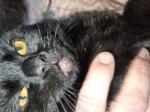Sorting Out Male Cat Behavior and Making Sense of Kitty's Moves
Male cat behavior is synonymous with words like unpredictable, aggressive, aloof, and unapproachable. These descriptions are usually accompanied by claims of spraying and urine marking, as well as scratching up the couch.
In short, males are often associated with problem behavior, and thought to be more aggressive, but that's not really accurate. While there are distinctions (and we'll get to some specifics in a moment), both females and males have many similar behavior patterns in common, stemming largely from instinctual drives.
If you have a male cat with behavior problems then you may have been told that's just the way it is, but most times, you can reach some sort of agreement with your cat.
Note: A cat, male or female, that has not been properly socialized as a kitten may have deep seated behavior issues that are best addressed with the help of a pet psychologist. Likewise, a cat that has been through a trauma of some kind, such as a car accident, may also have issues that require professional help.
In addition, it should also be noted that emotional problems in cats are strongly tied to medical problems and illnesses, and it's often hard to tell which came first. If you have a pet cat and are experiencing a behavior problem, I highly recommend that you first talk to your vet. Then, if needed, consult with a pet psychologist, preferably one who has extensive experience with cats.
Cats can get themselves into trouble over toilet paper rolls, new leather sofas, wires, clean laundry, and flowers. Male cats, however, have more of a reputation for bad behavior than that of the female variety of Felis catus.
Male cat behavior is really no less predictable or mischievous than that of the female feline. But, predictable doesn't necessarily mean good. Do boy cats deserve their reputation for being bad kitties? Maybe, but let's see if we can understand a bit about why they do some of things they do.
Cats and Territory
It's all about the territory. A cat sets up a territory as part of basic survival. Territories provide a means of setting up protection and a place to hunt and mate.
With outdoor cats in a given area, territories will be decided based on status. Male cats are known as tomcats or just toms. Generally speaking, the most powerful tomcat in the area will have the largest territory.
Not surprisingly, male cat behavior is often associated with roaming and fighting. You can't blame your cat for wanting to get out and patrol or hunt, or wanting to find a mate, or wanting to fight off invaders. This is just part of what tomcats do.
Misplaced Aggression
You're not much of a tomcat if you can't protect your territory. Fighting is part of the job. Sometimes, however, aggression can become "misplaced."
A good example of this is when an indoor cat is threatened by a cat outside. Many multiple cat owners will report that when a stray or neighborhood cat visits their yard, their cats (who normally get along) will fight with each other.
This is known as misplaced or misdirected aggression and can happen with males or females, but is often more extreme in males.
This can happen even if your cat is 100 percent indoors. Your cat feels that his territory has been threatened, but is frustrated since he can't get to the offender. Instead, that frustration turns into misplaced aggression and he attacks his housemate. He may even attack other pets or people in the house.
Providing a cat sanctuary in the house can help with this, as it gives your cat a safe place to go and feel secure. Feliway pheromone spray may help to reduce aggression between housemates, or simply calm your cat in general.
Effects of Neutering on Male Cat Behavior
Some people claim that neutering or spaying makes for a fat, lazy cat that sits around and does nothing. This is simply not true, although, as I mention below, the metabolism does slow down.
Hunting instincts and play behavior are there whether or not your cat has been neutered. Cats often get fat more out of lack of stimulation and lack of regular exercise than anything.
Male cats that have not been altered, sometimes referred to as "full males," however, are definitely more prone to roaming and fighting. So, neutering your male can result in a decrease in problem behavior due to aggression and territorial issues.
A number of celebrities with cats, such as Betty White, have proclaimed the benefits of getting your cat neutered. Often this is for reasons of over population. Many animals are put to death each year because homes are not found for them.
Other benefits of neutering are a less pungent urine odor, reduced urine marking and spraying, reduced destructive scratching behavior, and as discussed, reduced aggression.
Jazzy was howling every night before I got him neutered. Thankfully, that behavior promptly stopped after his neuter surgery.
He was driving me up the wall with his nighttime antics. As soon as it got dark, he would head for the front door and howl.
In between howls, I would often catch Jazzy sticking his nose in the crack of the door and sniffing, sucking in all the air he could. I'm fairly convinced there were lady cats outside, and he couldn't contain himself.
My vet told me that I need to watch his food intake because his metabolism would slow down post-neuter. He wanted to make sure I wasn't feeding him "free choice."
I feed him meals, though, rather than free choice, and I also exercise him daily and weigh him occasionally to make sure we're on track.
Marking, Spraying, and Scratching Behavior
Urine marking and spraying behavior is a way of communicating and declaring territory. Leaving your scent says "this is mine." Scratching behavior not only sharpens the claws, but also leaves behind a cat's scent from the glands in the feet.
Both females and males exhibit these behaviors, but it tends to be more extreme in males. Neutering your male cat will reduce the tendency to mark and spray.
Scratching also releases stress, and you need to teach your cat appropriate scratching. That means providing a scratching post or board for him. If you also reduce tension and aggression by giving your male cat a place to call his own, he'll feel more secure and will tend not to act out and rough up your couch.
Other Topics Related to Male Cat Behavior
Thinking like a cat in order to solve a behavior problem
More about the behavior patterns of the domestic cat



Comments: What do you think?
Have your say about what you just read. Leave me a comment in the box below.